Construction Project Management Case Study of THE SCOTTISH PARLIAMENT
VerifiedAdded on 2022/03/08
|13
|3923
|47
AI Summary
Construction is one of those platforms that require good management in order to be successful. The management of the project is important not just in the construction field, but in all fields, and the management of construction organization literally involves the organization, direction, expansion of the project life cycle, as well as the proper innovation of the project.
Contribute Materials
Your contribution can guide someone’s learning journey. Share your
documents today.
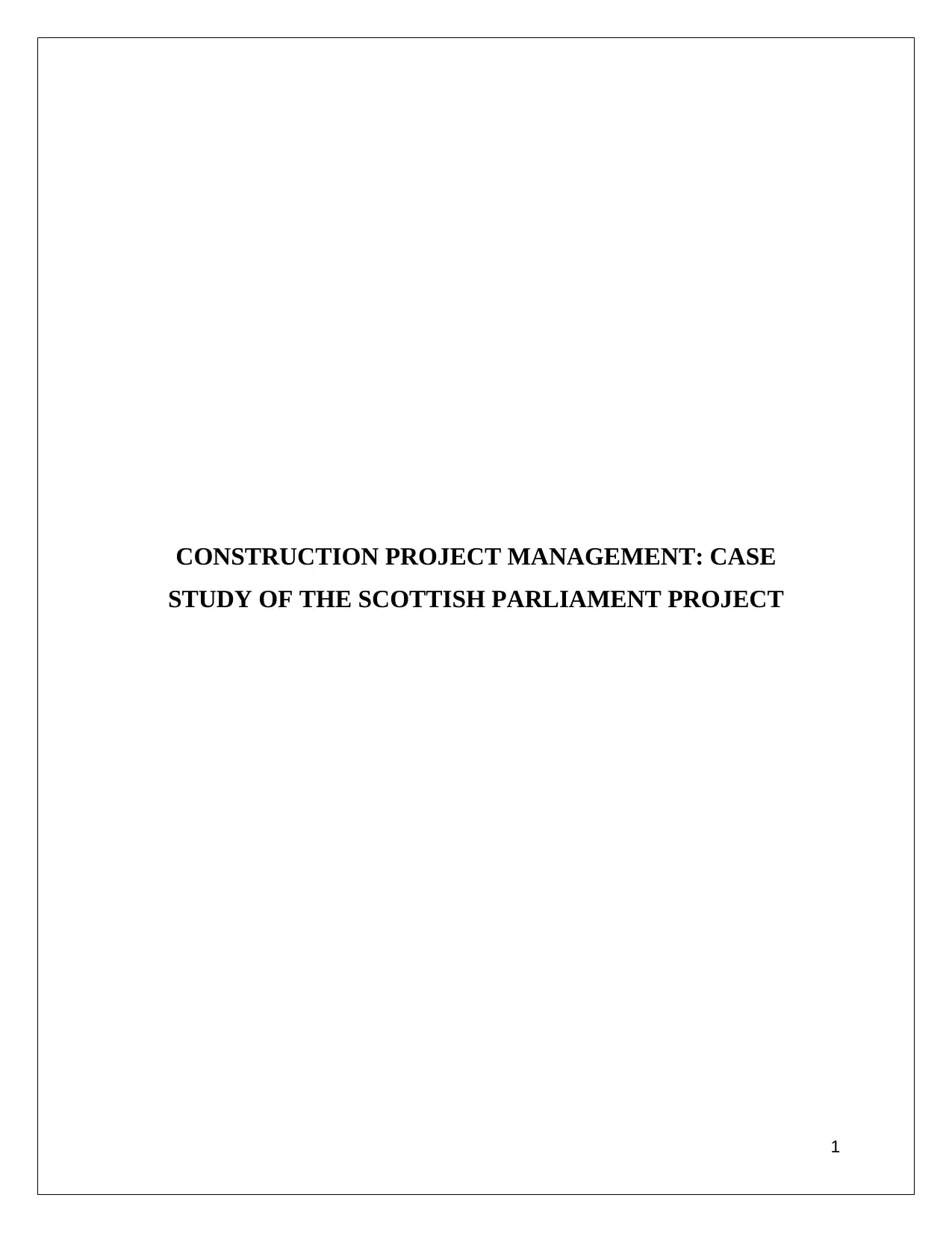
CONSTRUCTION PROJECT MANAGEMENT: CASE
STUDY OF THE SCOTTISH PARLIAMENT PROJECT
1
STUDY OF THE SCOTTISH PARLIAMENT PROJECT
1
Secure Best Marks with AI Grader
Need help grading? Try our AI Grader for instant feedback on your assignments.
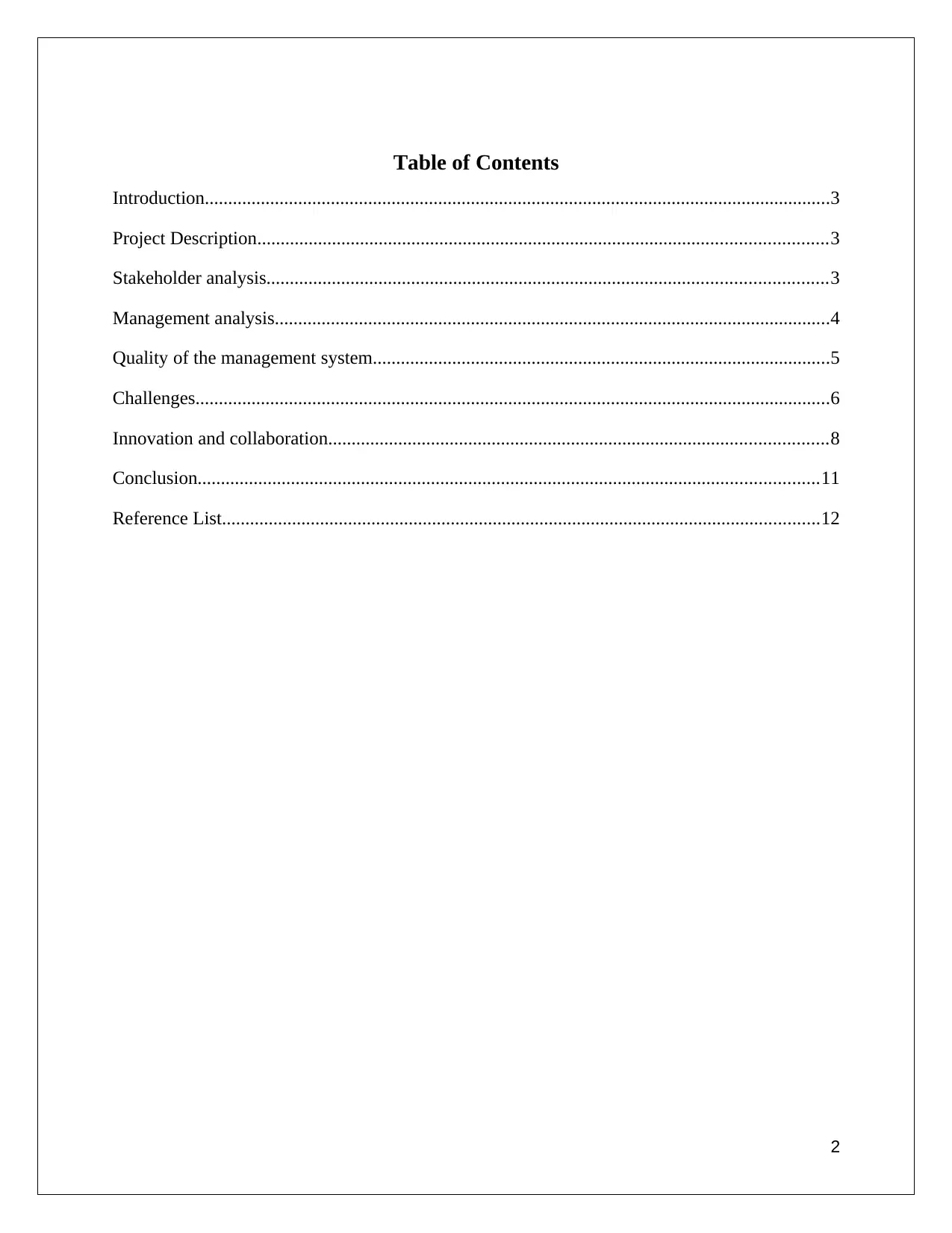
Table of Contents
Introduction......................................................................................................................................3
Project Description..........................................................................................................................3
Stakeholder analysis........................................................................................................................3
Management analysis.......................................................................................................................4
Quality of the management system..................................................................................................5
Challenges........................................................................................................................................6
Innovation and collaboration...........................................................................................................8
Conclusion.....................................................................................................................................11
Reference List................................................................................................................................12
2
Introduction......................................................................................................................................3
Project Description..........................................................................................................................3
Stakeholder analysis........................................................................................................................3
Management analysis.......................................................................................................................4
Quality of the management system..................................................................................................5
Challenges........................................................................................................................................6
Innovation and collaboration...........................................................................................................8
Conclusion.....................................................................................................................................11
Reference List................................................................................................................................12
2
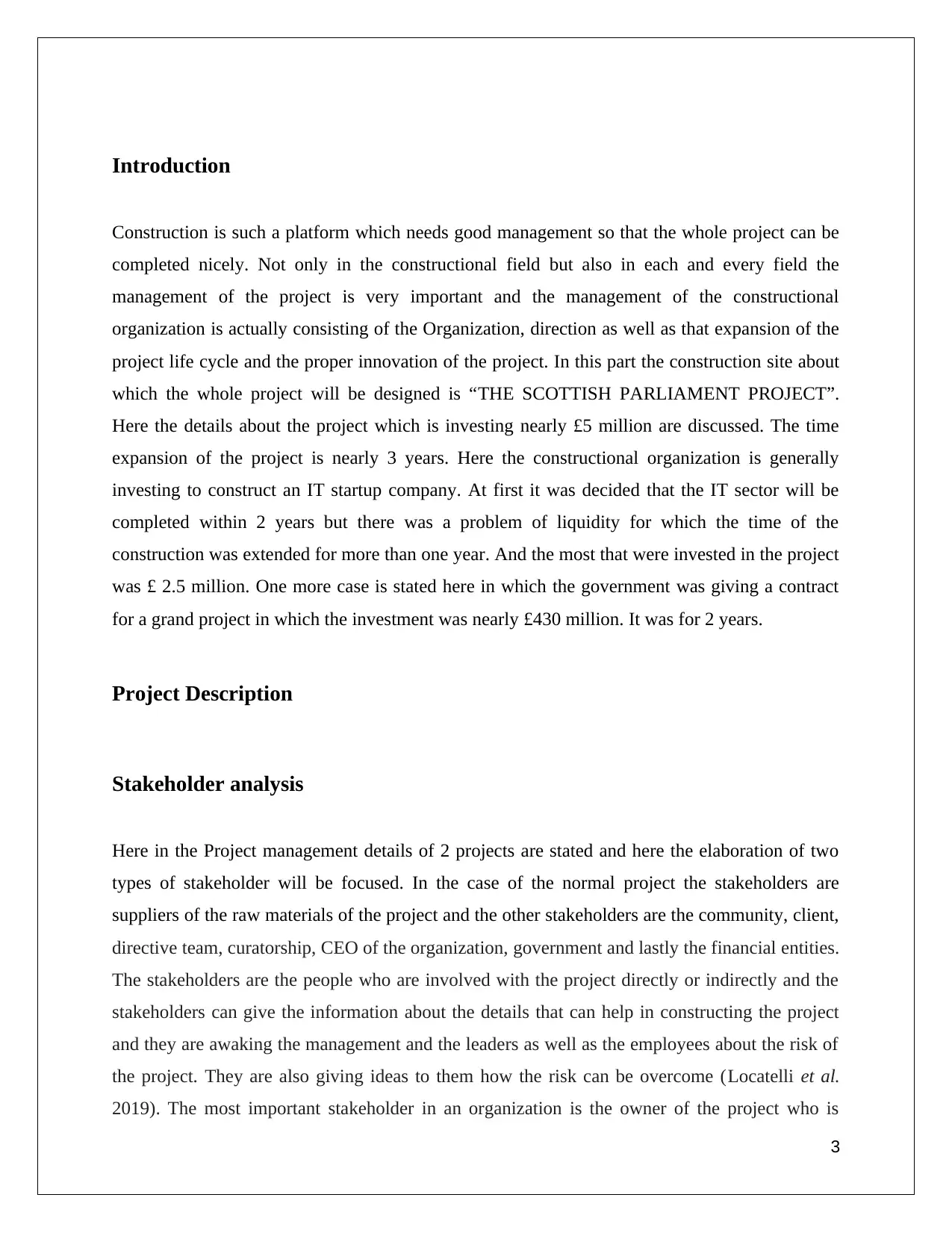
Introduction
Construction is such a platform which needs good management so that the whole project can be
completed nicely. Not only in the constructional field but also in each and every field the
management of the project is very important and the management of the constructional
organization is actually consisting of the Organization, direction as well as that expansion of the
project life cycle and the proper innovation of the project. In this part the construction site about
which the whole project will be designed is “THE SCOTTISH PARLIAMENT PROJECT”.
Here the details about the project which is investing nearly £5 million are discussed. The time
expansion of the project is nearly 3 years. Here the constructional organization is generally
investing to construct an IT startup company. At first it was decided that the IT sector will be
completed within 2 years but there was a problem of liquidity for which the time of the
construction was extended for more than one year. And the most that were invested in the project
was £ 2.5 million. One more case is stated here in which the government was giving a contract
for a grand project in which the investment was nearly £430 million. It was for 2 years.
Project Description
Stakeholder analysis
Here in the Project management details of 2 projects are stated and here the elaboration of two
types of stakeholder will be focused. In the case of the normal project the stakeholders are
suppliers of the raw materials of the project and the other stakeholders are the community, client,
directive team, curatorship, CEO of the organization, government and lastly the financial entities.
The stakeholders are the people who are involved with the project directly or indirectly and the
stakeholders can give the information about the details that can help in constructing the project
and they are awaking the management and the leaders as well as the employees about the risk of
the project. They are also giving ideas to them how the risk can be overcome (Locatelli et al.
2019). The most important stakeholder in an organization is the owner of the project who is
3
Construction is such a platform which needs good management so that the whole project can be
completed nicely. Not only in the constructional field but also in each and every field the
management of the project is very important and the management of the constructional
organization is actually consisting of the Organization, direction as well as that expansion of the
project life cycle and the proper innovation of the project. In this part the construction site about
which the whole project will be designed is “THE SCOTTISH PARLIAMENT PROJECT”.
Here the details about the project which is investing nearly £5 million are discussed. The time
expansion of the project is nearly 3 years. Here the constructional organization is generally
investing to construct an IT startup company. At first it was decided that the IT sector will be
completed within 2 years but there was a problem of liquidity for which the time of the
construction was extended for more than one year. And the most that were invested in the project
was £ 2.5 million. One more case is stated here in which the government was giving a contract
for a grand project in which the investment was nearly £430 million. It was for 2 years.
Project Description
Stakeholder analysis
Here in the Project management details of 2 projects are stated and here the elaboration of two
types of stakeholder will be focused. In the case of the normal project the stakeholders are
suppliers of the raw materials of the project and the other stakeholders are the community, client,
directive team, curatorship, CEO of the organization, government and lastly the financial entities.
The stakeholders are the people who are involved with the project directly or indirectly and the
stakeholders can give the information about the details that can help in constructing the project
and they are awaking the management and the leaders as well as the employees about the risk of
the project. They are also giving ideas to them how the risk can be overcome (Locatelli et al.
2019). The most important stakeholder in an organization is the owner of the project who is
3
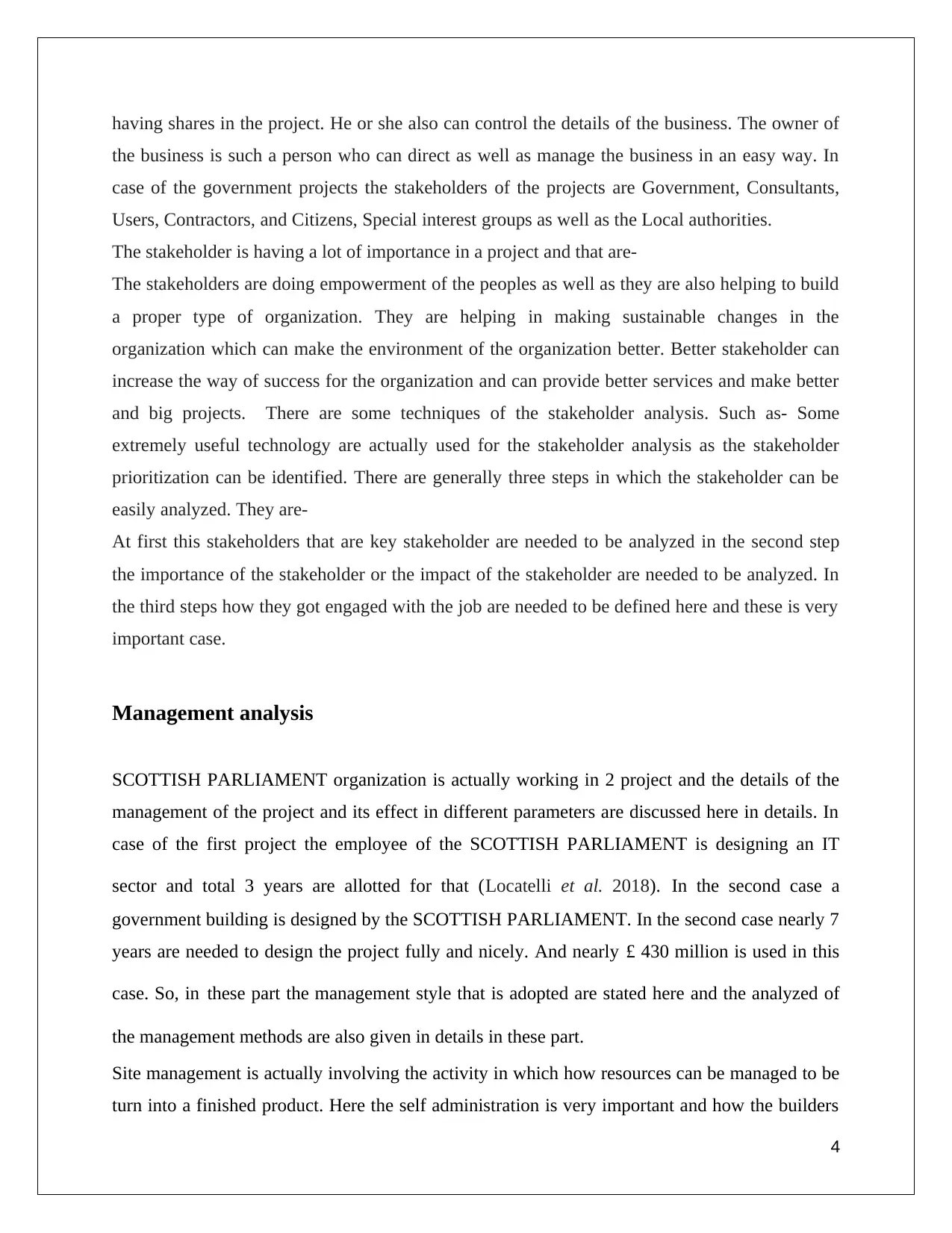
having shares in the project. He or she also can control the details of the business. The owner of
the business is such a person who can direct as well as manage the business in an easy way. In
case of the government projects the stakeholders of the projects are Government, Consultants,
Users, Contractors, and Citizens, Special interest groups as well as the Local authorities.
The stakeholder is having a lot of importance in a project and that are-
The stakeholders are doing empowerment of the peoples as well as they are also helping to build
a proper type of organization. They are helping in making sustainable changes in the
organization which can make the environment of the organization better. Better stakeholder can
increase the way of success for the organization and can provide better services and make better
and big projects. There are some techniques of the stakeholder analysis. Such as- Some
extremely useful technology are actually used for the stakeholder analysis as the stakeholder
prioritization can be identified. There are generally three steps in which the stakeholder can be
easily analyzed. They are-
At first this stakeholders that are key stakeholder are needed to be analyzed in the second step
the importance of the stakeholder or the impact of the stakeholder are needed to be analyzed. In
the third steps how they got engaged with the job are needed to be defined here and these is very
important case.
Management analysis
SCOTTISH PARLIAMENT organization is actually working in 2 project and the details of the
management of the project and its effect in different parameters are discussed here in details. In
case of the first project the employee of the SCOTTISH PARLIAMENT is designing an IT
sector and total 3 years are allotted for that (Locatelli et al. 2018). In the second case a
government building is designed by the SCOTTISH PARLIAMENT. In the second case nearly 7
years are needed to design the project fully and nicely. And nearly £ 430 million is used in this
case. So, in these part the management style that is adopted are stated here and the analyzed of
the management methods are also given in details in these part.
Site management is actually involving the activity in which how resources can be managed to be
turn into a finished product. Here the self administration is very important and how the builders
4
the business is such a person who can direct as well as manage the business in an easy way. In
case of the government projects the stakeholders of the projects are Government, Consultants,
Users, Contractors, and Citizens, Special interest groups as well as the Local authorities.
The stakeholder is having a lot of importance in a project and that are-
The stakeholders are doing empowerment of the peoples as well as they are also helping to build
a proper type of organization. They are helping in making sustainable changes in the
organization which can make the environment of the organization better. Better stakeholder can
increase the way of success for the organization and can provide better services and make better
and big projects. There are some techniques of the stakeholder analysis. Such as- Some
extremely useful technology are actually used for the stakeholder analysis as the stakeholder
prioritization can be identified. There are generally three steps in which the stakeholder can be
easily analyzed. They are-
At first this stakeholders that are key stakeholder are needed to be analyzed in the second step
the importance of the stakeholder or the impact of the stakeholder are needed to be analyzed. In
the third steps how they got engaged with the job are needed to be defined here and these is very
important case.
Management analysis
SCOTTISH PARLIAMENT organization is actually working in 2 project and the details of the
management of the project and its effect in different parameters are discussed here in details. In
case of the first project the employee of the SCOTTISH PARLIAMENT is designing an IT
sector and total 3 years are allotted for that (Locatelli et al. 2018). In the second case a
government building is designed by the SCOTTISH PARLIAMENT. In the second case nearly 7
years are needed to design the project fully and nicely. And nearly £ 430 million is used in this
case. So, in these part the management style that is adopted are stated here and the analyzed of
the management methods are also given in details in these part.
Site management is actually involving the activity in which how resources can be managed to be
turn into a finished product. Here the self administration is very important and how the builders
4
Secure Best Marks with AI Grader
Need help grading? Try our AI Grader for instant feedback on your assignments.
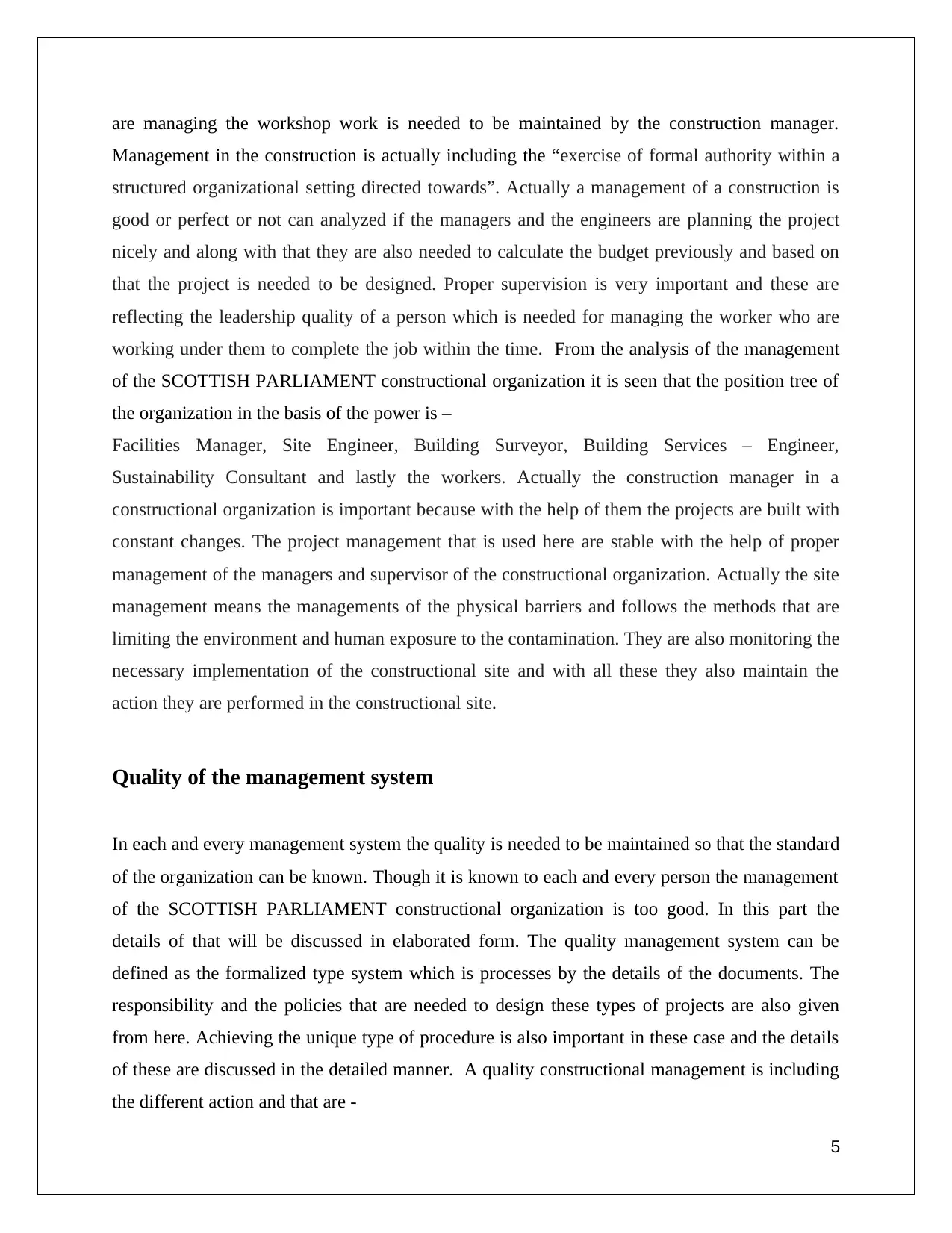
are managing the workshop work is needed to be maintained by the construction manager.
Management in the construction is actually including the “exercise of formal authority within a
structured organizational setting directed towards”. Actually a management of a construction is
good or perfect or not can analyzed if the managers and the engineers are planning the project
nicely and along with that they are also needed to calculate the budget previously and based on
that the project is needed to be designed. Proper supervision is very important and these are
reflecting the leadership quality of a person which is needed for managing the worker who are
working under them to complete the job within the time. From the analysis of the management
of the SCOTTISH PARLIAMENT constructional organization it is seen that the position tree of
the organization in the basis of the power is –
Facilities Manager, Site Engineer, Building Surveyor, Building Services – Engineer,
Sustainability Consultant and lastly the workers. Actually the construction manager in a
constructional organization is important because with the help of them the projects are built with
constant changes. The project management that is used here are stable with the help of proper
management of the managers and supervisor of the constructional organization. Actually the site
management means the managements of the physical barriers and follows the methods that are
limiting the environment and human exposure to the contamination. They are also monitoring the
necessary implementation of the constructional site and with all these they also maintain the
action they are performed in the constructional site.
Quality of the management system
In each and every management system the quality is needed to be maintained so that the standard
of the organization can be known. Though it is known to each and every person the management
of the SCOTTISH PARLIAMENT constructional organization is too good. In this part the
details of that will be discussed in elaborated form. The quality management system can be
defined as the formalized type system which is processes by the details of the documents. The
responsibility and the policies that are needed to design these types of projects are also given
from here. Achieving the unique type of procedure is also important in these case and the details
of these are discussed in the detailed manner. A quality constructional management is including
the different action and that are -
5
Management in the construction is actually including the “exercise of formal authority within a
structured organizational setting directed towards”. Actually a management of a construction is
good or perfect or not can analyzed if the managers and the engineers are planning the project
nicely and along with that they are also needed to calculate the budget previously and based on
that the project is needed to be designed. Proper supervision is very important and these are
reflecting the leadership quality of a person which is needed for managing the worker who are
working under them to complete the job within the time. From the analysis of the management
of the SCOTTISH PARLIAMENT constructional organization it is seen that the position tree of
the organization in the basis of the power is –
Facilities Manager, Site Engineer, Building Surveyor, Building Services – Engineer,
Sustainability Consultant and lastly the workers. Actually the construction manager in a
constructional organization is important because with the help of them the projects are built with
constant changes. The project management that is used here are stable with the help of proper
management of the managers and supervisor of the constructional organization. Actually the site
management means the managements of the physical barriers and follows the methods that are
limiting the environment and human exposure to the contamination. They are also monitoring the
necessary implementation of the constructional site and with all these they also maintain the
action they are performed in the constructional site.
Quality of the management system
In each and every management system the quality is needed to be maintained so that the standard
of the organization can be known. Though it is known to each and every person the management
of the SCOTTISH PARLIAMENT constructional organization is too good. In this part the
details of that will be discussed in elaborated form. The quality management system can be
defined as the formalized type system which is processes by the details of the documents. The
responsibility and the policies that are needed to design these types of projects are also given
from here. Achieving the unique type of procedure is also important in these case and the details
of these are discussed in the detailed manner. A quality constructional management is including
the different action and that are -
5
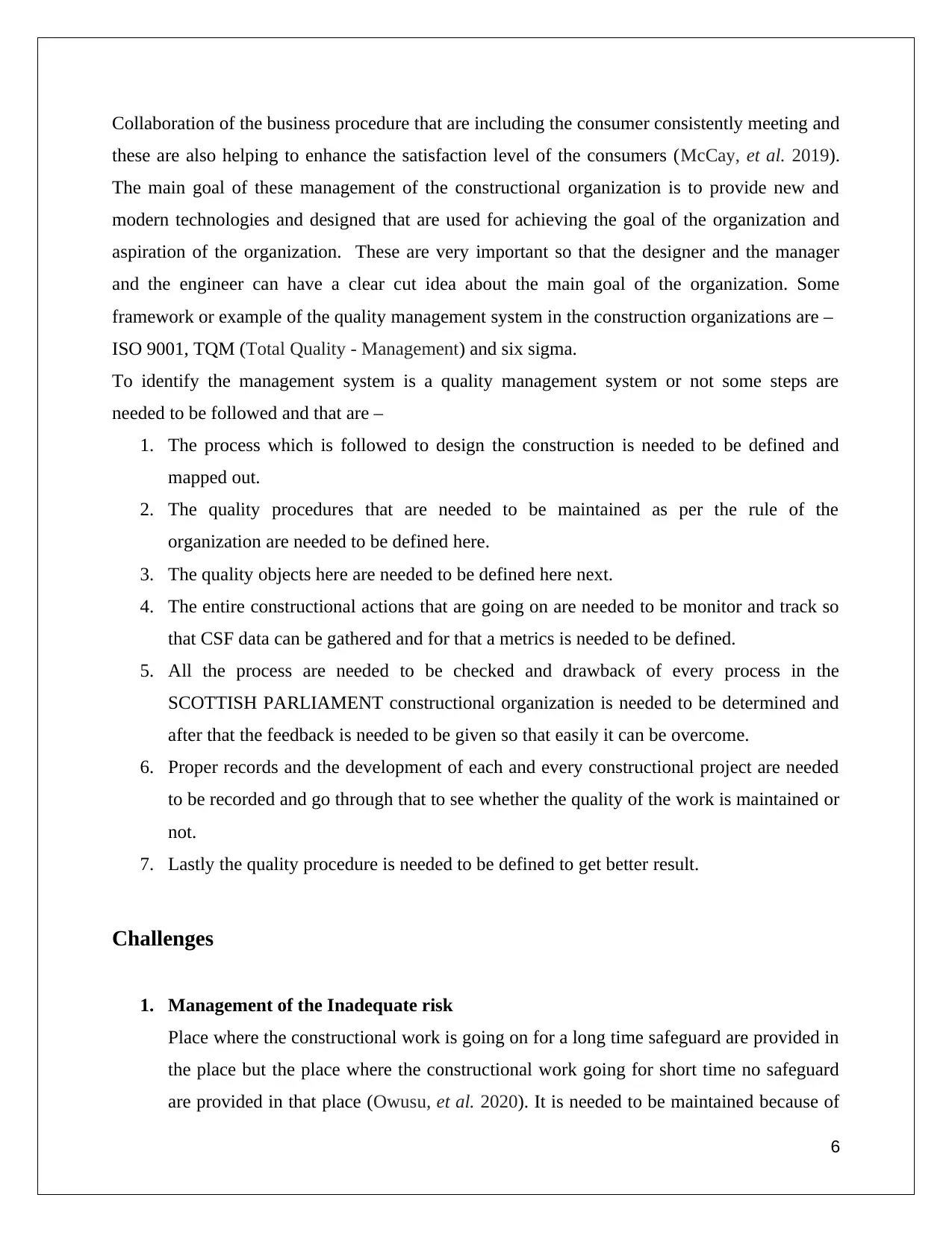
Collaboration of the business procedure that are including the consumer consistently meeting and
these are also helping to enhance the satisfaction level of the consumers (McCay, et al. 2019).
The main goal of these management of the constructional organization is to provide new and
modern technologies and designed that are used for achieving the goal of the organization and
aspiration of the organization. These are very important so that the designer and the manager
and the engineer can have a clear cut idea about the main goal of the organization. Some
framework or example of the quality management system in the construction organizations are –
ISO 9001, TQM (Total Quality - Management) and six sigma.
To identify the management system is a quality management system or not some steps are
needed to be followed and that are –
1. The process which is followed to design the construction is needed to be defined and
mapped out.
2. The quality procedures that are needed to be maintained as per the rule of the
organization are needed to be defined here.
3. The quality objects here are needed to be defined here next.
4. The entire constructional actions that are going on are needed to be monitor and track so
that CSF data can be gathered and for that a metrics is needed to be defined.
5. All the process are needed to be checked and drawback of every process in the
SCOTTISH PARLIAMENT constructional organization is needed to be determined and
after that the feedback is needed to be given so that easily it can be overcome.
6. Proper records and the development of each and every constructional project are needed
to be recorded and go through that to see whether the quality of the work is maintained or
not.
7. Lastly the quality procedure is needed to be defined to get better result.
Challenges
1. Management of the Inadequate risk
Place where the constructional work is going on for a long time safeguard are provided in
the place but the place where the constructional work going for short time no safeguard
are provided in that place (Owusu, et al. 2020). It is needed to be maintained because of
6
these are also helping to enhance the satisfaction level of the consumers (McCay, et al. 2019).
The main goal of these management of the constructional organization is to provide new and
modern technologies and designed that are used for achieving the goal of the organization and
aspiration of the organization. These are very important so that the designer and the manager
and the engineer can have a clear cut idea about the main goal of the organization. Some
framework or example of the quality management system in the construction organizations are –
ISO 9001, TQM (Total Quality - Management) and six sigma.
To identify the management system is a quality management system or not some steps are
needed to be followed and that are –
1. The process which is followed to design the construction is needed to be defined and
mapped out.
2. The quality procedures that are needed to be maintained as per the rule of the
organization are needed to be defined here.
3. The quality objects here are needed to be defined here next.
4. The entire constructional actions that are going on are needed to be monitor and track so
that CSF data can be gathered and for that a metrics is needed to be defined.
5. All the process are needed to be checked and drawback of every process in the
SCOTTISH PARLIAMENT constructional organization is needed to be determined and
after that the feedback is needed to be given so that easily it can be overcome.
6. Proper records and the development of each and every constructional project are needed
to be recorded and go through that to see whether the quality of the work is maintained or
not.
7. Lastly the quality procedure is needed to be defined to get better result.
Challenges
1. Management of the Inadequate risk
Place where the constructional work is going on for a long time safeguard are provided in
the place but the place where the constructional work going for short time no safeguard
are provided in that place (Owusu, et al. 2020). It is needed to be maintained because of
6
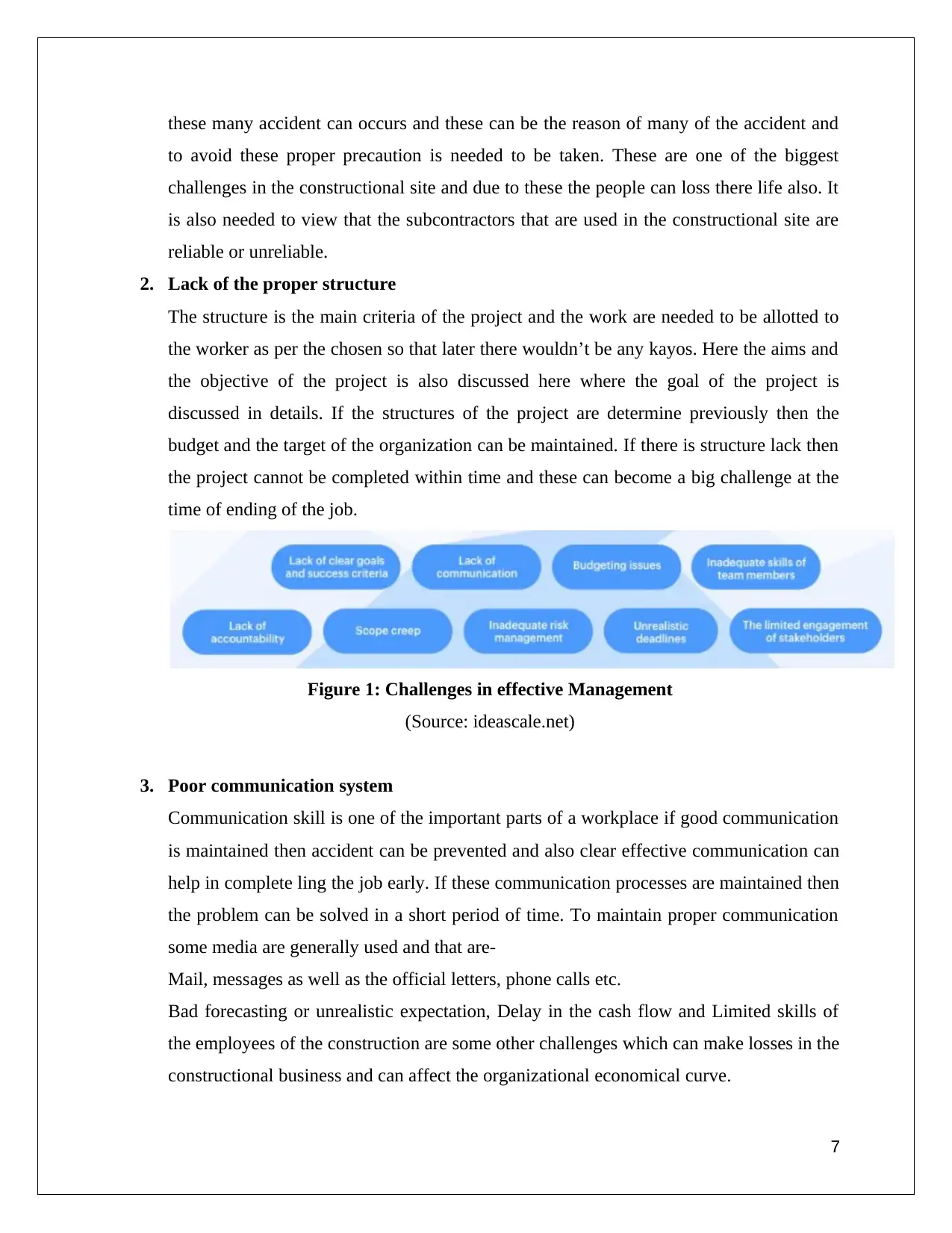
these many accident can occurs and these can be the reason of many of the accident and
to avoid these proper precaution is needed to be taken. These are one of the biggest
challenges in the constructional site and due to these the people can loss there life also. It
is also needed to view that the subcontractors that are used in the constructional site are
reliable or unreliable.
2. Lack of the proper structure
The structure is the main criteria of the project and the work are needed to be allotted to
the worker as per the chosen so that later there wouldn’t be any kayos. Here the aims and
the objective of the project is also discussed here where the goal of the project is
discussed in details. If the structures of the project are determine previously then the
budget and the target of the organization can be maintained. If there is structure lack then
the project cannot be completed within time and these can become a big challenge at the
time of ending of the job.
Figure 1: Challenges in effective Management
(Source: ideascale.net)
3. Poor communication system
Communication skill is one of the important parts of a workplace if good communication
is maintained then accident can be prevented and also clear effective communication can
help in complete ling the job early. If these communication processes are maintained then
the problem can be solved in a short period of time. To maintain proper communication
some media are generally used and that are-
Mail, messages as well as the official letters, phone calls etc.
Bad forecasting or unrealistic expectation, Delay in the cash flow and Limited skills of
the employees of the construction are some other challenges which can make losses in the
constructional business and can affect the organizational economical curve.
7
to avoid these proper precaution is needed to be taken. These are one of the biggest
challenges in the constructional site and due to these the people can loss there life also. It
is also needed to view that the subcontractors that are used in the constructional site are
reliable or unreliable.
2. Lack of the proper structure
The structure is the main criteria of the project and the work are needed to be allotted to
the worker as per the chosen so that later there wouldn’t be any kayos. Here the aims and
the objective of the project is also discussed here where the goal of the project is
discussed in details. If the structures of the project are determine previously then the
budget and the target of the organization can be maintained. If there is structure lack then
the project cannot be completed within time and these can become a big challenge at the
time of ending of the job.
Figure 1: Challenges in effective Management
(Source: ideascale.net)
3. Poor communication system
Communication skill is one of the important parts of a workplace if good communication
is maintained then accident can be prevented and also clear effective communication can
help in complete ling the job early. If these communication processes are maintained then
the problem can be solved in a short period of time. To maintain proper communication
some media are generally used and that are-
Mail, messages as well as the official letters, phone calls etc.
Bad forecasting or unrealistic expectation, Delay in the cash flow and Limited skills of
the employees of the construction are some other challenges which can make losses in the
constructional business and can affect the organizational economical curve.
7
Paraphrase This Document
Need a fresh take? Get an instant paraphrase of this document with our AI Paraphraser
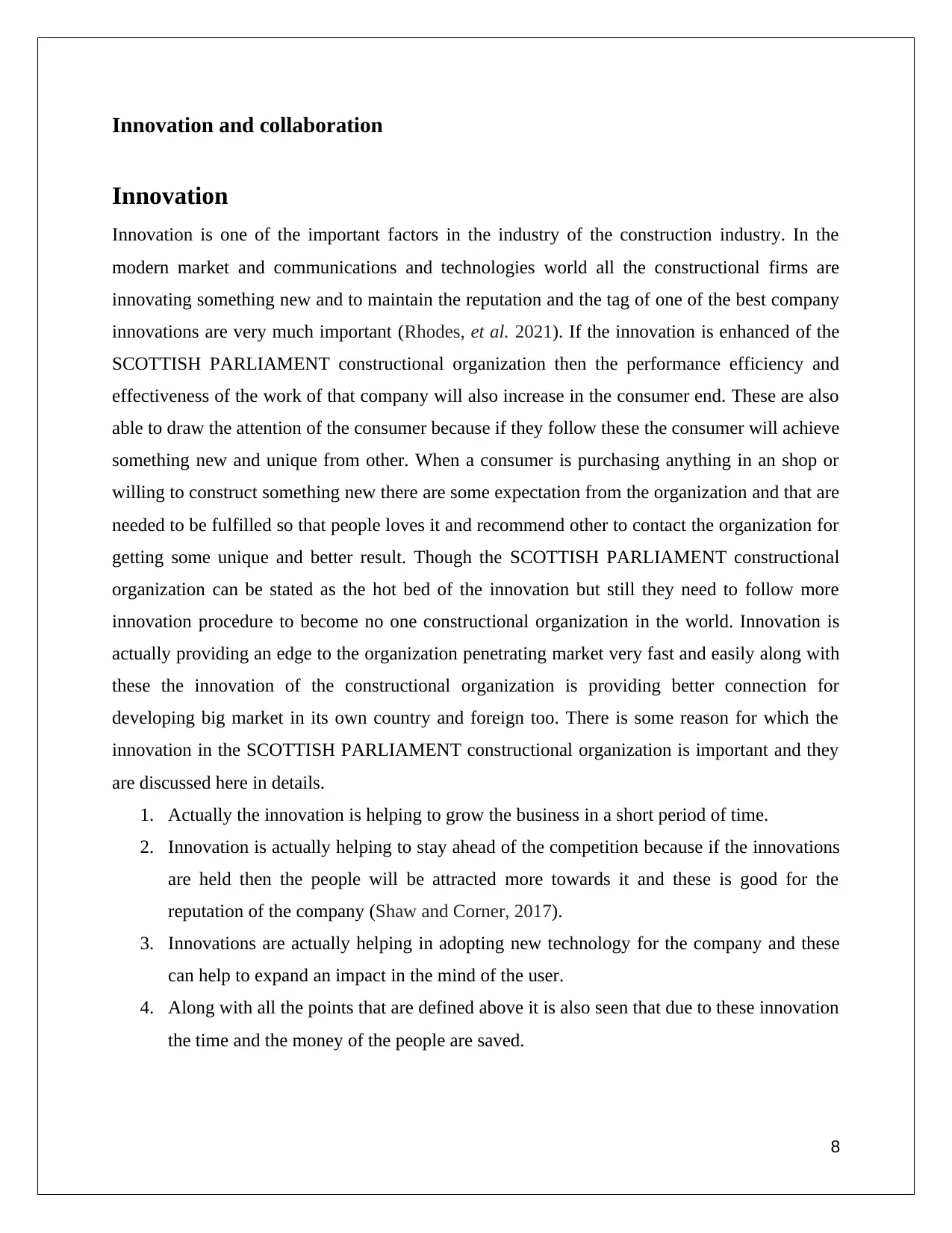
Innovation and collaboration
Innovation
Innovation is one of the important factors in the industry of the construction industry. In the
modern market and communications and technologies world all the constructional firms are
innovating something new and to maintain the reputation and the tag of one of the best company
innovations are very much important (Rhodes, et al. 2021). If the innovation is enhanced of the
SCOTTISH PARLIAMENT constructional organization then the performance efficiency and
effectiveness of the work of that company will also increase in the consumer end. These are also
able to draw the attention of the consumer because if they follow these the consumer will achieve
something new and unique from other. When a consumer is purchasing anything in an shop or
willing to construct something new there are some expectation from the organization and that are
needed to be fulfilled so that people loves it and recommend other to contact the organization for
getting some unique and better result. Though the SCOTTISH PARLIAMENT constructional
organization can be stated as the hot bed of the innovation but still they need to follow more
innovation procedure to become no one constructional organization in the world. Innovation is
actually providing an edge to the organization penetrating market very fast and easily along with
these the innovation of the constructional organization is providing better connection for
developing big market in its own country and foreign too. There is some reason for which the
innovation in the SCOTTISH PARLIAMENT constructional organization is important and they
are discussed here in details.
1. Actually the innovation is helping to grow the business in a short period of time.
2. Innovation is actually helping to stay ahead of the competition because if the innovations
are held then the people will be attracted more towards it and these is good for the
reputation of the company (Shaw and Corner, 2017).
3. Innovations are actually helping in adopting new technology for the company and these
can help to expand an impact in the mind of the user.
4. Along with all the points that are defined above it is also seen that due to these innovation
the time and the money of the people are saved.
8
Innovation
Innovation is one of the important factors in the industry of the construction industry. In the
modern market and communications and technologies world all the constructional firms are
innovating something new and to maintain the reputation and the tag of one of the best company
innovations are very much important (Rhodes, et al. 2021). If the innovation is enhanced of the
SCOTTISH PARLIAMENT constructional organization then the performance efficiency and
effectiveness of the work of that company will also increase in the consumer end. These are also
able to draw the attention of the consumer because if they follow these the consumer will achieve
something new and unique from other. When a consumer is purchasing anything in an shop or
willing to construct something new there are some expectation from the organization and that are
needed to be fulfilled so that people loves it and recommend other to contact the organization for
getting some unique and better result. Though the SCOTTISH PARLIAMENT constructional
organization can be stated as the hot bed of the innovation but still they need to follow more
innovation procedure to become no one constructional organization in the world. Innovation is
actually providing an edge to the organization penetrating market very fast and easily along with
these the innovation of the constructional organization is providing better connection for
developing big market in its own country and foreign too. There is some reason for which the
innovation in the SCOTTISH PARLIAMENT constructional organization is important and they
are discussed here in details.
1. Actually the innovation is helping to grow the business in a short period of time.
2. Innovation is actually helping to stay ahead of the competition because if the innovations
are held then the people will be attracted more towards it and these is good for the
reputation of the company (Shaw and Corner, 2017).
3. Innovations are actually helping in adopting new technology for the company and these
can help to expand an impact in the mind of the user.
4. Along with all the points that are defined above it is also seen that due to these innovation
the time and the money of the people are saved.
8
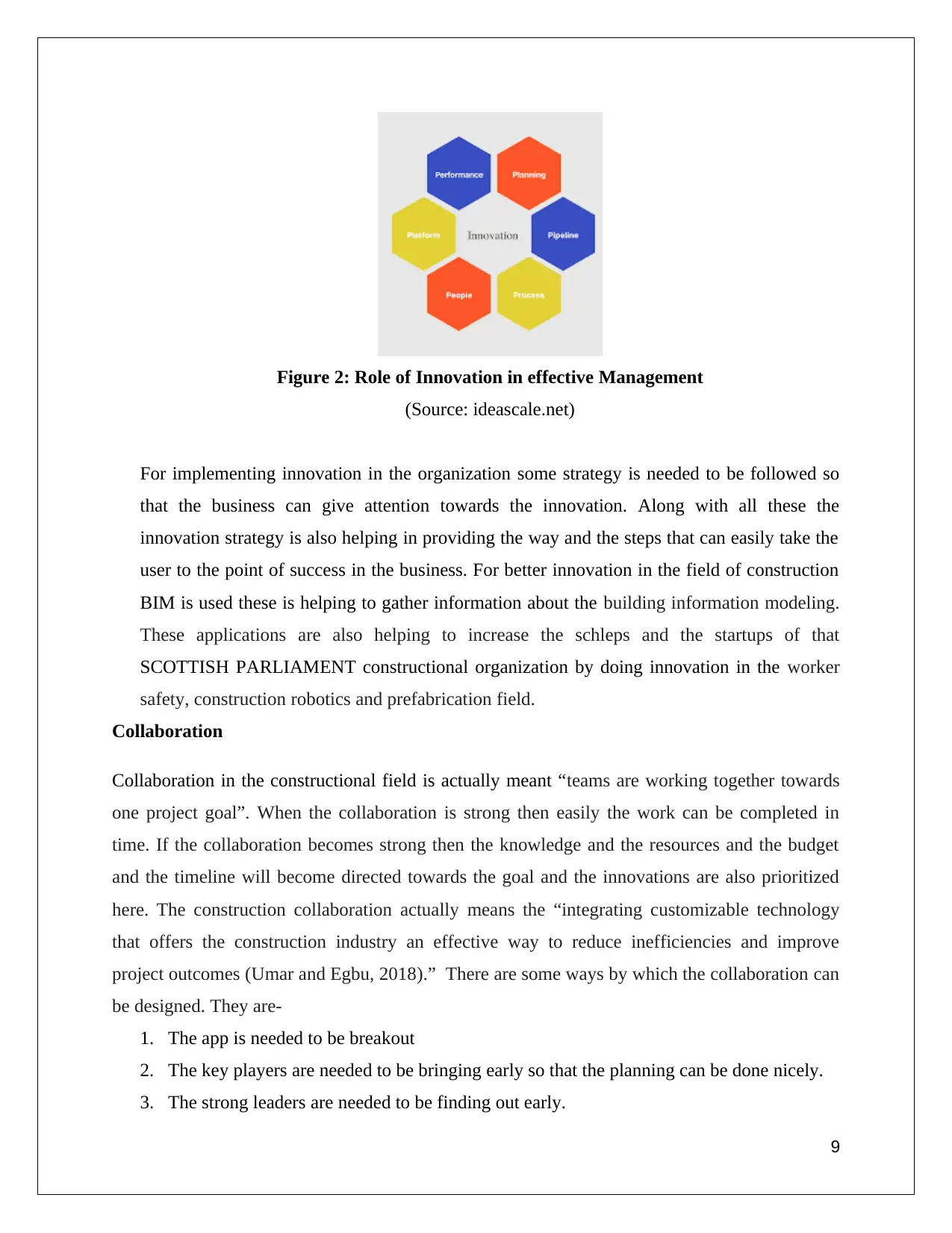
Figure 2: Role of Innovation in effective Management
(Source: ideascale.net)
For implementing innovation in the organization some strategy is needed to be followed so
that the business can give attention towards the innovation. Along with all these the
innovation strategy is also helping in providing the way and the steps that can easily take the
user to the point of success in the business. For better innovation in the field of construction
BIM is used these is helping to gather information about the building information modeling.
These applications are also helping to increase the schleps and the startups of that
SCOTTISH PARLIAMENT constructional organization by doing innovation in the worker
safety, construction robotics and prefabrication field.
Collaboration
Collaboration in the constructional field is actually meant “teams are working together towards
one project goal”. When the collaboration is strong then easily the work can be completed in
time. If the collaboration becomes strong then the knowledge and the resources and the budget
and the timeline will become directed towards the goal and the innovations are also prioritized
here. The construction collaboration actually means the “integrating customizable technology
that offers the construction industry an effective way to reduce inefficiencies and improve
project outcomes (Umar and Egbu, 2018).” There are some ways by which the collaboration can
be designed. They are-
1. The app is needed to be breakout
2. The key players are needed to be bringing early so that the planning can be done nicely.
3. The strong leaders are needed to be finding out early.
9
(Source: ideascale.net)
For implementing innovation in the organization some strategy is needed to be followed so
that the business can give attention towards the innovation. Along with all these the
innovation strategy is also helping in providing the way and the steps that can easily take the
user to the point of success in the business. For better innovation in the field of construction
BIM is used these is helping to gather information about the building information modeling.
These applications are also helping to increase the schleps and the startups of that
SCOTTISH PARLIAMENT constructional organization by doing innovation in the worker
safety, construction robotics and prefabrication field.
Collaboration
Collaboration in the constructional field is actually meant “teams are working together towards
one project goal”. When the collaboration is strong then easily the work can be completed in
time. If the collaboration becomes strong then the knowledge and the resources and the budget
and the timeline will become directed towards the goal and the innovations are also prioritized
here. The construction collaboration actually means the “integrating customizable technology
that offers the construction industry an effective way to reduce inefficiencies and improve
project outcomes (Umar and Egbu, 2018).” There are some ways by which the collaboration can
be designed. They are-
1. The app is needed to be breakout
2. The key players are needed to be bringing early so that the planning can be done nicely.
3. The strong leaders are needed to be finding out early.
9
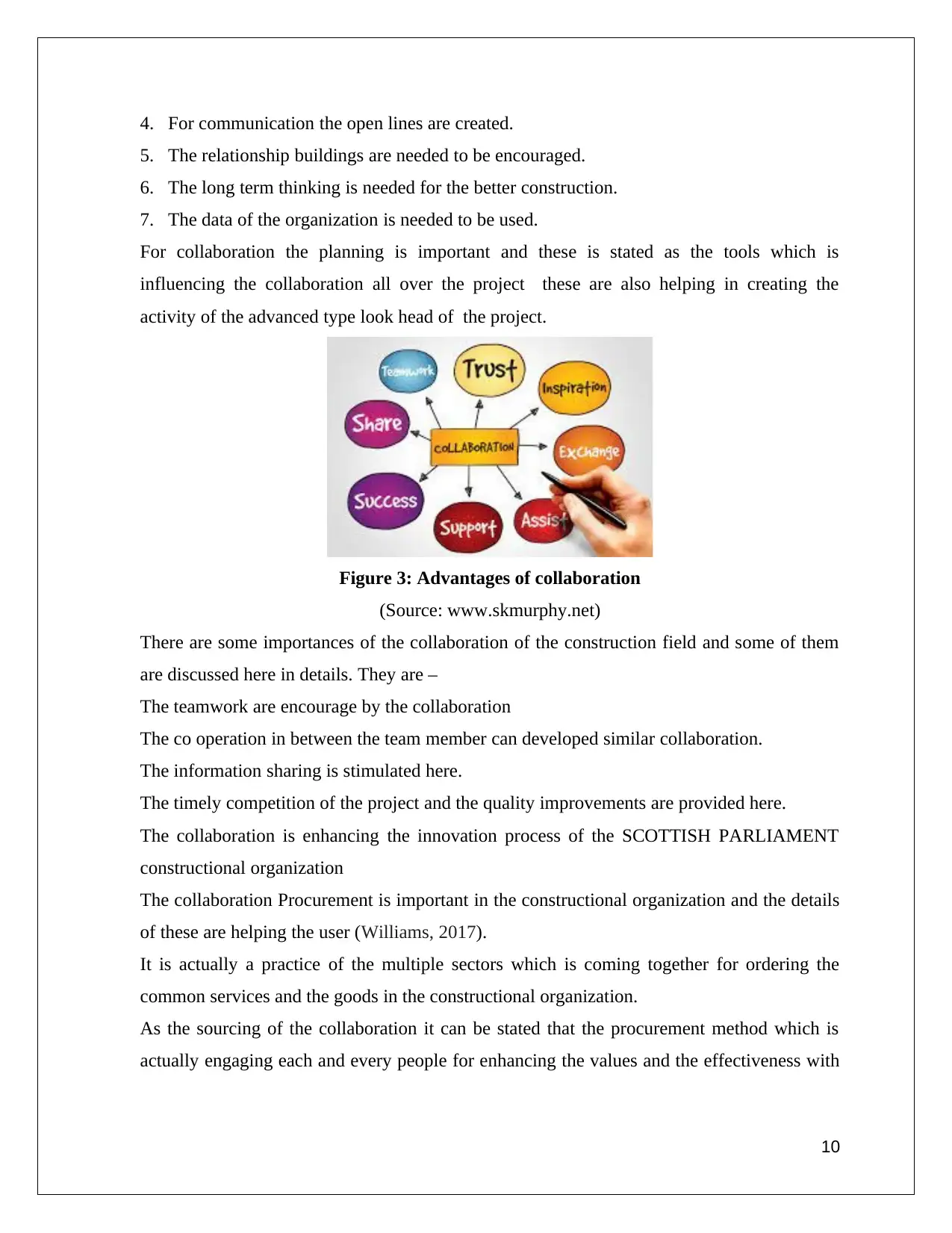
4. For communication the open lines are created.
5. The relationship buildings are needed to be encouraged.
6. The long term thinking is needed for the better construction.
7. The data of the organization is needed to be used.
For collaboration the planning is important and these is stated as the tools which is
influencing the collaboration all over the project these are also helping in creating the
activity of the advanced type look head of the project.
Figure 3: Advantages of collaboration
(Source: www.skmurphy.net)
There are some importances of the collaboration of the construction field and some of them
are discussed here in details. They are –
The teamwork are encourage by the collaboration
The co operation in between the team member can developed similar collaboration.
The information sharing is stimulated here.
The timely competition of the project and the quality improvements are provided here.
The collaboration is enhancing the innovation process of the SCOTTISH PARLIAMENT
constructional organization
The collaboration Procurement is important in the constructional organization and the details
of these are helping the user (Williams, 2017).
It is actually a practice of the multiple sectors which is coming together for ordering the
common services and the goods in the constructional organization.
As the sourcing of the collaboration it can be stated that the procurement method which is
actually engaging each and every people for enhancing the values and the effectiveness with
10
5. The relationship buildings are needed to be encouraged.
6. The long term thinking is needed for the better construction.
7. The data of the organization is needed to be used.
For collaboration the planning is important and these is stated as the tools which is
influencing the collaboration all over the project these are also helping in creating the
activity of the advanced type look head of the project.
Figure 3: Advantages of collaboration
(Source: www.skmurphy.net)
There are some importances of the collaboration of the construction field and some of them
are discussed here in details. They are –
The teamwork are encourage by the collaboration
The co operation in between the team member can developed similar collaboration.
The information sharing is stimulated here.
The timely competition of the project and the quality improvements are provided here.
The collaboration is enhancing the innovation process of the SCOTTISH PARLIAMENT
constructional organization
The collaboration Procurement is important in the constructional organization and the details
of these are helping the user (Williams, 2017).
It is actually a practice of the multiple sectors which is coming together for ordering the
common services and the goods in the constructional organization.
As the sourcing of the collaboration it can be stated that the procurement method which is
actually engaging each and every people for enhancing the values and the effectiveness with
10
Secure Best Marks with AI Grader
Need help grading? Try our AI Grader for instant feedback on your assignments.
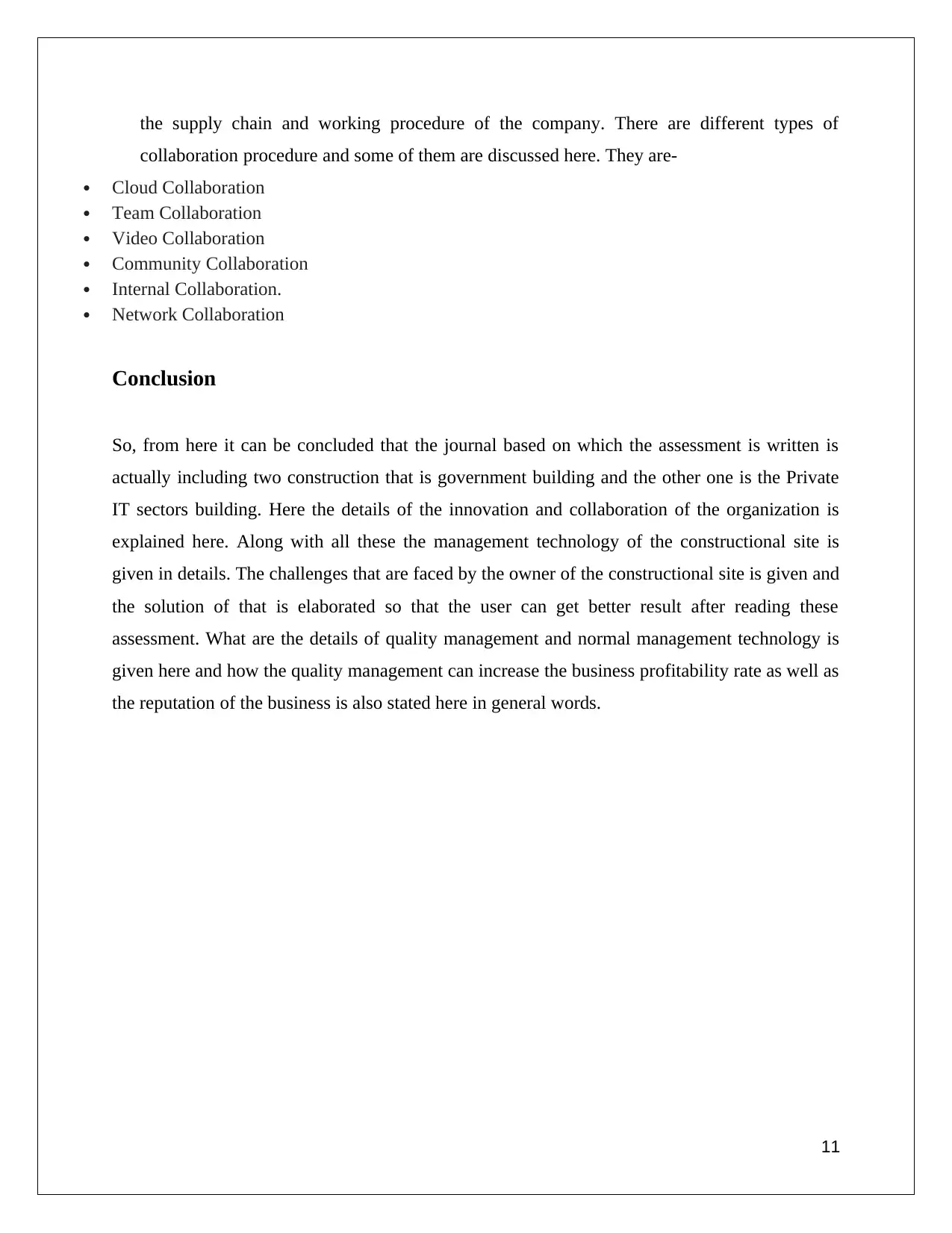
the supply chain and working procedure of the company. There are different types of
collaboration procedure and some of them are discussed here. They are-
Cloud Collaboration
Team Collaboration
Video Collaboration
Community Collaboration
Internal Collaboration.
Network Collaboration
Conclusion
So, from here it can be concluded that the journal based on which the assessment is written is
actually including two construction that is government building and the other one is the Private
IT sectors building. Here the details of the innovation and collaboration of the organization is
explained here. Along with all these the management technology of the constructional site is
given in details. The challenges that are faced by the owner of the constructional site is given and
the solution of that is elaborated so that the user can get better result after reading these
assessment. What are the details of quality management and normal management technology is
given here and how the quality management can increase the business profitability rate as well as
the reputation of the business is also stated here in general words.
11
collaboration procedure and some of them are discussed here. They are-
Cloud Collaboration
Team Collaboration
Video Collaboration
Community Collaboration
Internal Collaboration.
Network Collaboration
Conclusion
So, from here it can be concluded that the journal based on which the assessment is written is
actually including two construction that is government building and the other one is the Private
IT sectors building. Here the details of the innovation and collaboration of the organization is
explained here. Along with all these the management technology of the constructional site is
given in details. The challenges that are faced by the owner of the constructional site is given and
the solution of that is elaborated so that the user can get better result after reading these
assessment. What are the details of quality management and normal management technology is
given here and how the quality management can increase the business profitability rate as well as
the reputation of the business is also stated here in general words.
11
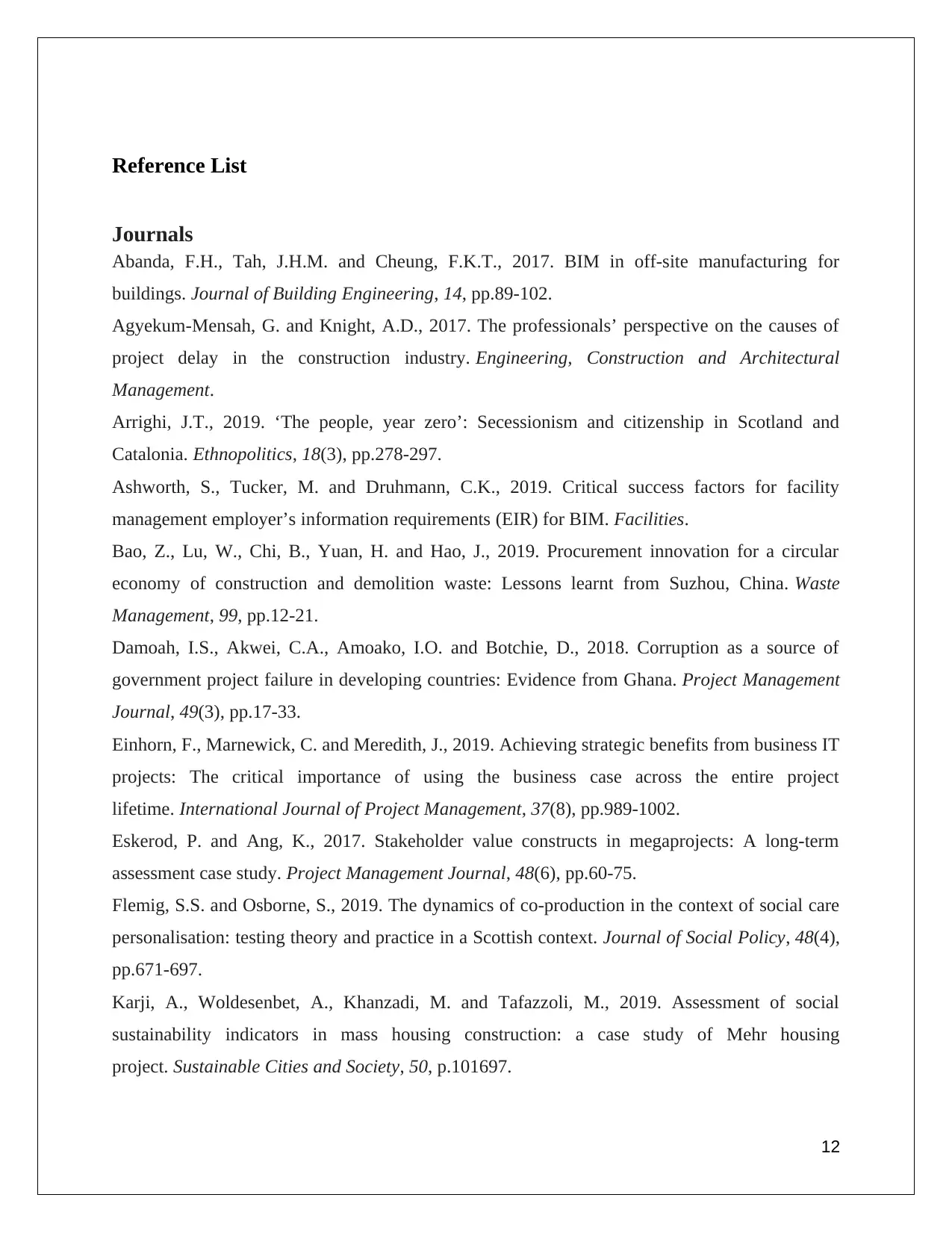
Reference List
Journals
Abanda, F.H., Tah, J.H.M. and Cheung, F.K.T., 2017. BIM in off-site manufacturing for
buildings. Journal of Building Engineering, 14, pp.89-102.
Agyekum-Mensah, G. and Knight, A.D., 2017. The professionals’ perspective on the causes of
project delay in the construction industry. Engineering, Construction and Architectural
Management.
Arrighi, J.T., 2019. ‘The people, year zero’: Secessionism and citizenship in Scotland and
Catalonia. Ethnopolitics, 18(3), pp.278-297.
Ashworth, S., Tucker, M. and Druhmann, C.K., 2019. Critical success factors for facility
management employer’s information requirements (EIR) for BIM. Facilities.
Bao, Z., Lu, W., Chi, B., Yuan, H. and Hao, J., 2019. Procurement innovation for a circular
economy of construction and demolition waste: Lessons learnt from Suzhou, China. Waste
Management, 99, pp.12-21.
Damoah, I.S., Akwei, C.A., Amoako, I.O. and Botchie, D., 2018. Corruption as a source of
government project failure in developing countries: Evidence from Ghana. Project Management
Journal, 49(3), pp.17-33.
Einhorn, F., Marnewick, C. and Meredith, J., 2019. Achieving strategic benefits from business IT
projects: The critical importance of using the business case across the entire project
lifetime. International Journal of Project Management, 37(8), pp.989-1002.
Eskerod, P. and Ang, K., 2017. Stakeholder value constructs in megaprojects: A long-term
assessment case study. Project Management Journal, 48(6), pp.60-75.
Flemig, S.S. and Osborne, S., 2019. The dynamics of co-production in the context of social care
personalisation: testing theory and practice in a Scottish context. Journal of Social Policy, 48(4),
pp.671-697.
Karji, A., Woldesenbet, A., Khanzadi, M. and Tafazzoli, M., 2019. Assessment of social
sustainability indicators in mass housing construction: a case study of Mehr housing
project. Sustainable Cities and Society, 50, p.101697.
12
Journals
Abanda, F.H., Tah, J.H.M. and Cheung, F.K.T., 2017. BIM in off-site manufacturing for
buildings. Journal of Building Engineering, 14, pp.89-102.
Agyekum-Mensah, G. and Knight, A.D., 2017. The professionals’ perspective on the causes of
project delay in the construction industry. Engineering, Construction and Architectural
Management.
Arrighi, J.T., 2019. ‘The people, year zero’: Secessionism and citizenship in Scotland and
Catalonia. Ethnopolitics, 18(3), pp.278-297.
Ashworth, S., Tucker, M. and Druhmann, C.K., 2019. Critical success factors for facility
management employer’s information requirements (EIR) for BIM. Facilities.
Bao, Z., Lu, W., Chi, B., Yuan, H. and Hao, J., 2019. Procurement innovation for a circular
economy of construction and demolition waste: Lessons learnt from Suzhou, China. Waste
Management, 99, pp.12-21.
Damoah, I.S., Akwei, C.A., Amoako, I.O. and Botchie, D., 2018. Corruption as a source of
government project failure in developing countries: Evidence from Ghana. Project Management
Journal, 49(3), pp.17-33.
Einhorn, F., Marnewick, C. and Meredith, J., 2019. Achieving strategic benefits from business IT
projects: The critical importance of using the business case across the entire project
lifetime. International Journal of Project Management, 37(8), pp.989-1002.
Eskerod, P. and Ang, K., 2017. Stakeholder value constructs in megaprojects: A long-term
assessment case study. Project Management Journal, 48(6), pp.60-75.
Flemig, S.S. and Osborne, S., 2019. The dynamics of co-production in the context of social care
personalisation: testing theory and practice in a Scottish context. Journal of Social Policy, 48(4),
pp.671-697.
Karji, A., Woldesenbet, A., Khanzadi, M. and Tafazzoli, M., 2019. Assessment of social
sustainability indicators in mass housing construction: a case study of Mehr housing
project. Sustainable Cities and Society, 50, p.101697.
12
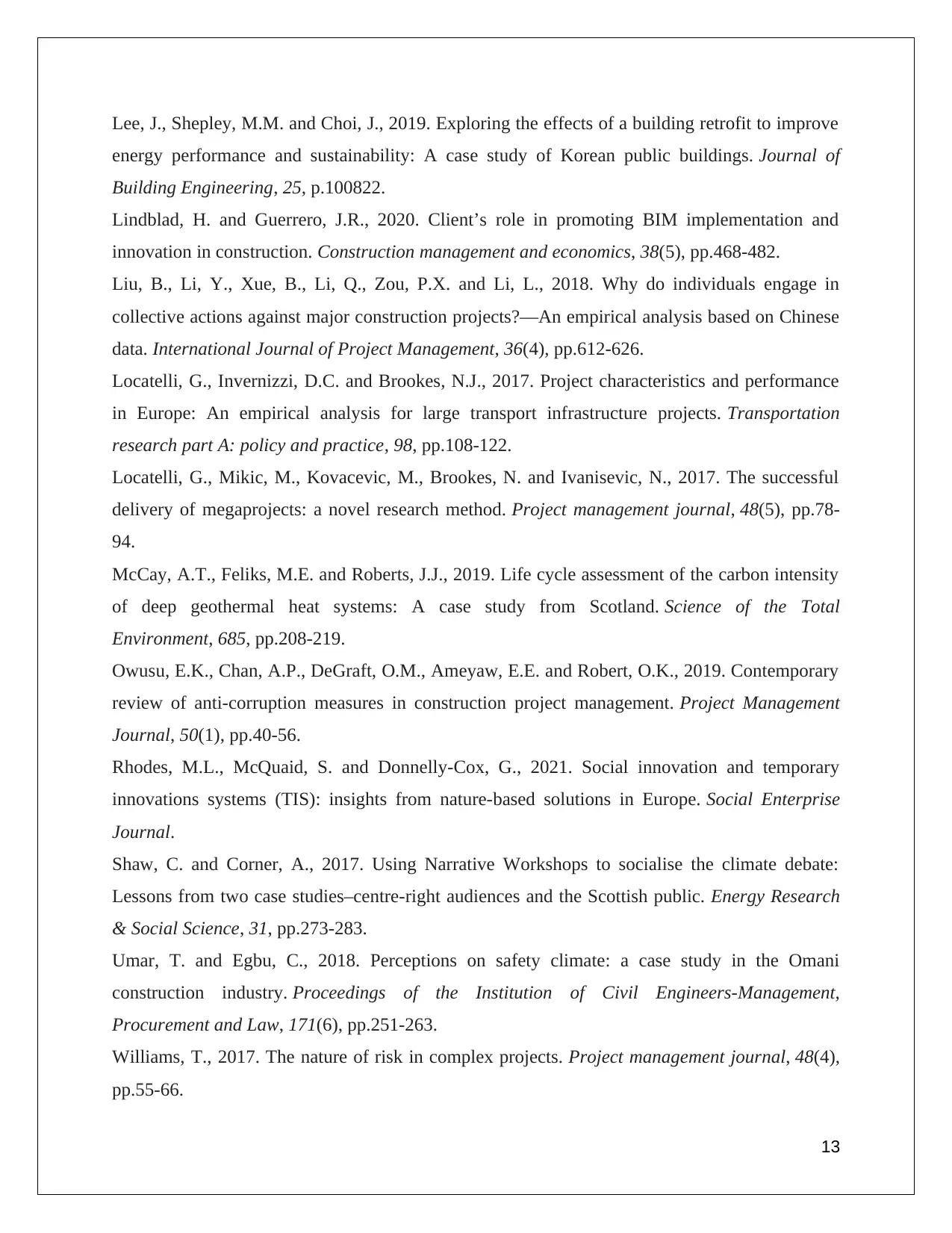
Lee, J., Shepley, M.M. and Choi, J., 2019. Exploring the effects of a building retrofit to improve
energy performance and sustainability: A case study of Korean public buildings. Journal of
Building Engineering, 25, p.100822.
Lindblad, H. and Guerrero, J.R., 2020. Client’s role in promoting BIM implementation and
innovation in construction. Construction management and economics, 38(5), pp.468-482.
Liu, B., Li, Y., Xue, B., Li, Q., Zou, P.X. and Li, L., 2018. Why do individuals engage in
collective actions against major construction projects?—An empirical analysis based on Chinese
data. International Journal of Project Management, 36(4), pp.612-626.
Locatelli, G., Invernizzi, D.C. and Brookes, N.J., 2017. Project characteristics and performance
in Europe: An empirical analysis for large transport infrastructure projects. Transportation
research part A: policy and practice, 98, pp.108-122.
Locatelli, G., Mikic, M., Kovacevic, M., Brookes, N. and Ivanisevic, N., 2017. The successful
delivery of megaprojects: a novel research method. Project management journal, 48(5), pp.78-
94.
McCay, A.T., Feliks, M.E. and Roberts, J.J., 2019. Life cycle assessment of the carbon intensity
of deep geothermal heat systems: A case study from Scotland. Science of the Total
Environment, 685, pp.208-219.
Owusu, E.K., Chan, A.P., DeGraft, O.M., Ameyaw, E.E. and Robert, O.K., 2019. Contemporary
review of anti-corruption measures in construction project management. Project Management
Journal, 50(1), pp.40-56.
Rhodes, M.L., McQuaid, S. and Donnelly-Cox, G., 2021. Social innovation and temporary
innovations systems (TIS): insights from nature-based solutions in Europe. Social Enterprise
Journal.
Shaw, C. and Corner, A., 2017. Using Narrative Workshops to socialise the climate debate:
Lessons from two case studies–centre-right audiences and the Scottish public. Energy Research
& Social Science, 31, pp.273-283.
Umar, T. and Egbu, C., 2018. Perceptions on safety climate: a case study in the Omani
construction industry. Proceedings of the Institution of Civil Engineers-Management,
Procurement and Law, 171(6), pp.251-263.
Williams, T., 2017. The nature of risk in complex projects. Project management journal, 48(4),
pp.55-66.
13
energy performance and sustainability: A case study of Korean public buildings. Journal of
Building Engineering, 25, p.100822.
Lindblad, H. and Guerrero, J.R., 2020. Client’s role in promoting BIM implementation and
innovation in construction. Construction management and economics, 38(5), pp.468-482.
Liu, B., Li, Y., Xue, B., Li, Q., Zou, P.X. and Li, L., 2018. Why do individuals engage in
collective actions against major construction projects?—An empirical analysis based on Chinese
data. International Journal of Project Management, 36(4), pp.612-626.
Locatelli, G., Invernizzi, D.C. and Brookes, N.J., 2017. Project characteristics and performance
in Europe: An empirical analysis for large transport infrastructure projects. Transportation
research part A: policy and practice, 98, pp.108-122.
Locatelli, G., Mikic, M., Kovacevic, M., Brookes, N. and Ivanisevic, N., 2017. The successful
delivery of megaprojects: a novel research method. Project management journal, 48(5), pp.78-
94.
McCay, A.T., Feliks, M.E. and Roberts, J.J., 2019. Life cycle assessment of the carbon intensity
of deep geothermal heat systems: A case study from Scotland. Science of the Total
Environment, 685, pp.208-219.
Owusu, E.K., Chan, A.P., DeGraft, O.M., Ameyaw, E.E. and Robert, O.K., 2019. Contemporary
review of anti-corruption measures in construction project management. Project Management
Journal, 50(1), pp.40-56.
Rhodes, M.L., McQuaid, S. and Donnelly-Cox, G., 2021. Social innovation and temporary
innovations systems (TIS): insights from nature-based solutions in Europe. Social Enterprise
Journal.
Shaw, C. and Corner, A., 2017. Using Narrative Workshops to socialise the climate debate:
Lessons from two case studies–centre-right audiences and the Scottish public. Energy Research
& Social Science, 31, pp.273-283.
Umar, T. and Egbu, C., 2018. Perceptions on safety climate: a case study in the Omani
construction industry. Proceedings of the Institution of Civil Engineers-Management,
Procurement and Law, 171(6), pp.251-263.
Williams, T., 2017. The nature of risk in complex projects. Project management journal, 48(4),
pp.55-66.
13
1 out of 13
Related Documents
Your All-in-One AI-Powered Toolkit for Academic Success.
+13062052269
info@desklib.com
Available 24*7 on WhatsApp / Email
![[object Object]](/_next/static/media/star-bottom.7253800d.svg)
Unlock your academic potential
© 2024 | Zucol Services PVT LTD | All rights reserved.





